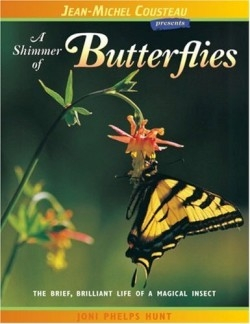A Shimmer of Butterflies
The Brief Brilliant Life of a Magical Insect
The life of a butterfly “is not as carefree as it looks,” writes the author. Peril is everywhere. To avoid predators, butterflies in their various stages of the life cycle may use tricky disguises, such as that of “decaying leaves; bees; hummingbirds; or even bird droppings.” The camera’s eye shares butterfly secrets and enemies.
As if evading peril were not enough, “butterflies have deadlines,” explains Hunt. Those deadlines involve meeting other butterflies, mating, producing young, and making sure that future generations reproduce, often within a few short weeks. (Not all of the 250,000 types of moths and butterflies are doomed to such short existence; there are a few exceptions.) In their brief flutter of life, these creatures go through metamorphosis, serve as pollinators, and may eat meals that surprise readers: “Many butterflies sip on urine, sweat, and slug slime” for necessary salts nutrients, and proteins, Hunt writes, noting that “caterpillars have appetites bigger than teenagers.”
Among the many scientific tidbits that Hunt provides is an explanation of the simple distinctions between moths and butterflies: moths are nocturnal fliers, and rest with their wings flat. Their antennae are mostly feathery or straight, while the antennae of butterflies have knobby tips. Butterflies are most active in the day and rest with their wings upright.
This volume is the first in a series of more than thirty beautiful nature books for children. The photography is as thrilling as that taken for National Geographic and comparable publications. The text shimmers with intriguing scientific information while providing solid data for home or school research. The first four in the series feature butterflies, sea otters, hummingbirds, and tropical rain forests. Each has an appealing cover and title, immediately engaging all ages.
The pictures capture ethereal broad views of flower-filled meadows, where swallowtail butterflies feed on nectar, and forests where copper butterflies are nearly invisible to the naked eye. Close-ups display exquisite details, such as the brilliant scales of a butterfly’s wing or pearly eggs on a blade of grass, or rice-like eggs on a leaf that will eventually serve as a meal for the emerging caterpillars.
The author, a California resident, has written four previous nature books, including Insects, which won the National Science Teacher Award. The principal photographers for this book (there are fourteen others) hold degrees in zoology and science education, and their photos have appeared in books, major magazines, and national museums. Butterfly and moth “secrets,” a glossary, index, and other resources fill out the useful information.
Hunt’s appeal to readers to help save “our smallest friends” underscores butterflies’ importance on the planet as pollinators. The stunning pictures and fact-filled text should spur readers of all ages to plant butterfly gardens, visit butterfly reserves, and appreciate their beauty and labors when they flit by.
Disclosure: This article is not an endorsement, but a review. The publisher of this book provided free copies of the book to have their book reviewed by a professional reviewer. No fee was paid by the publisher for this review. Foreword Reviews only recommends books that we love. Foreword Magazine, Inc. is disclosing this in accordance with the Federal Trade Commission’s 16 CFR, Part 255.


